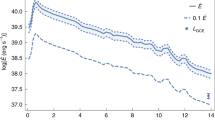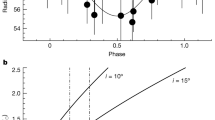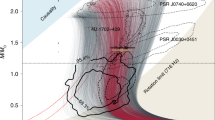Abstract
The extended non-thermal radio sources G357.7–0.1 and G5.3–1.0 in the galactic bulge have about the same energy content in the form of relativistic particles and magnetic fields as the brightest ordinary supernova remnants (original energy input ∼1050.5 erg), but differ from the latter in having a marked axial symmetry1,2. Their surface brightness gradually fades away towards one end of the symmetry axis, and at the opposite end one finds a compact radio source. The recently discovered radio source G18.95–1.1 (ref. 3) may belong to the same category. Helfand and Becker4 have argued that these structural properties can be explained most plausibly if these ‘remnants’ were produced by the ejection of matter with high kinetic energy by accreting binary systems at a rate ≫1037 erg s−1, the ejection lasting for several times 105 yr while the systems were travelling through the interstellar medium with a speed of ∼100 km s−1. We show here that the only type of neutron star binary that can fulfil both the condition of longevity and of a continuous high-mass transfer rate is a relatively wide binary in which the companion of the neutron star is a low-mass giant, with an orbital period of the order of weeks to months. Binaries of this type are expected to resemble closely the eight brightest galactic bulge X-ray sources5,6 as well as the progenitors of the two wide radio pulsar binaries7–9.
This is a preview of subscription content, access via your institution
Access options
Subscribe to this journal
Receive 51 print issues and online access
$199.00 per year
only $3.90 per issue
Buy this article
- Purchase on Springer Link
- Instant access to full article PDF
Prices may be subject to local taxes which are calculated during checkout
Similar content being viewed by others
References
Shaver, P. A., Salter, C. J., Patniack, A. R., van Gorkom, J. H. & Hunt, G. C. Nature 313, 113–115 (1985).
Becker, R. H. & Helfand, D. J. Nature 313, 115–118 (1985).
Fürst, E., Reich, W., Reich, P., Sofue, Y. & Handa, T. Nature 314, 720–721 (1985).
Helfand, D. J. & Becker, R. H. Nature 313, 118–119 (1985).
Webbink, R. F., Rappaport, S. & Savonije, G. J. Astrophys. J. 270, 678–693 (1983).
Taam, R. E. Astrophys. J. 270, 694–699 (1983).
Joss, P. C. & Rappaport, S. Nature 304, 419–421 (1983).
Savonije, G. J. Nature 304, 422–423 (1983).
Paczynski, B. Nature 304, 421–422 (1983).
Margon, B. A. Rev. Astr. Astrophys. 22, 507–536 (1984).
Geldzhaler, B. J., Fomalont, E. B., Hilldrup, K. & Corey, B. E. Astr. J. 86, 1036–1043 (1981).
Fomalont, E. B., Geldzhaler, B. J., Hjellming, R. M. & Wade, C. M. Astrophys. J. 275, 802–807 (1983).
Geldzhaler, B. J. et al. Astrophys. J. Lett. 273, L65–L69 (1983).
Bradt, H. V. D. & McClintock, J. E. A. Rev. Astr. Astrophys. 21, 13–66 (1983).
Shaver, P. et al. Astrophys. Lett. (in the press).
van den Heuvel, E. P. J. & Taam, R. E. Nature 309, 235–237 (1984).
Savonije, G. J. in Accretion Driven Stellar X-ray Sources, 343–366 (Cambridge University Press,1983).
Taam, R. E., Bodenheimer, P. & Ostriker, J. Astrophys. J. 222, 269–280 (1978).
Bodenheimer, P. & Taam, R. E. Astrophys. J. 280, 771–779 (1984).
Meyer, F. & Meyer-Hofmeister, E. Astr. Astrophys. 78, 167–176 (1979).
Rappaport, S., Joss, P. C. & Webbink, R. F. Astrophy. J. 254, 616–640 (1982).
Rappaport, S., Verbunt, F. & Joss, P. C. Astrophys. J. 275, 713–731 (1983).
Paczynski, B. Acta astr. 20, 47–58 (1970).
Kippenhahn, R. Astr. Astrophys. 102, 293–295 (1981).
Kudritzki, R. D. & Reimers, D. Astr. Astrophys. 70, 227–239 (1978).
Author information
Authors and Affiliations
Rights and permissions
About this article
Cite this article
de Kool, M., van den Heuvel, E. A wide low-mass binary model for the origin of axially symmetric non-thermal radio sources. Nature 317, 599–601 (1985). https://doi.org/10.1038/317599a0
Received:
Accepted:
Issue Date:
DOI: https://doi.org/10.1038/317599a0
This article is cited by
Comments
By submitting a comment you agree to abide by our Terms and Community Guidelines. If you find something abusive or that does not comply with our terms or guidelines please flag it as inappropriate.



